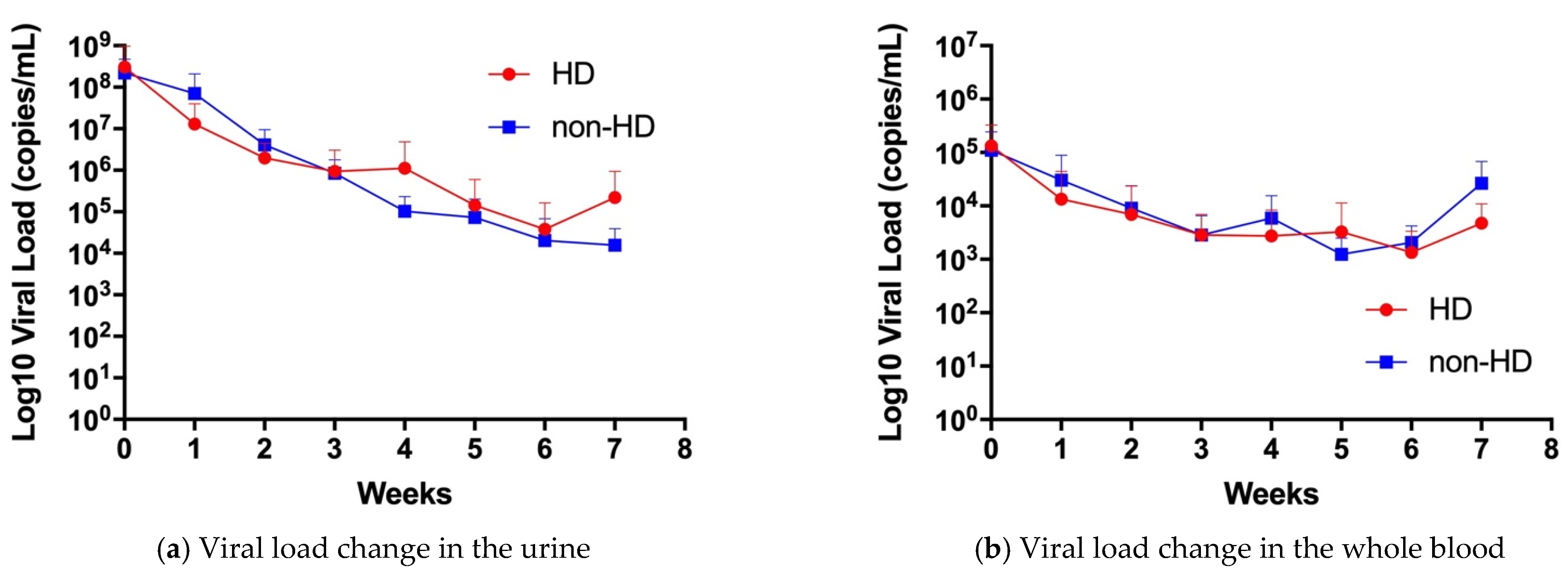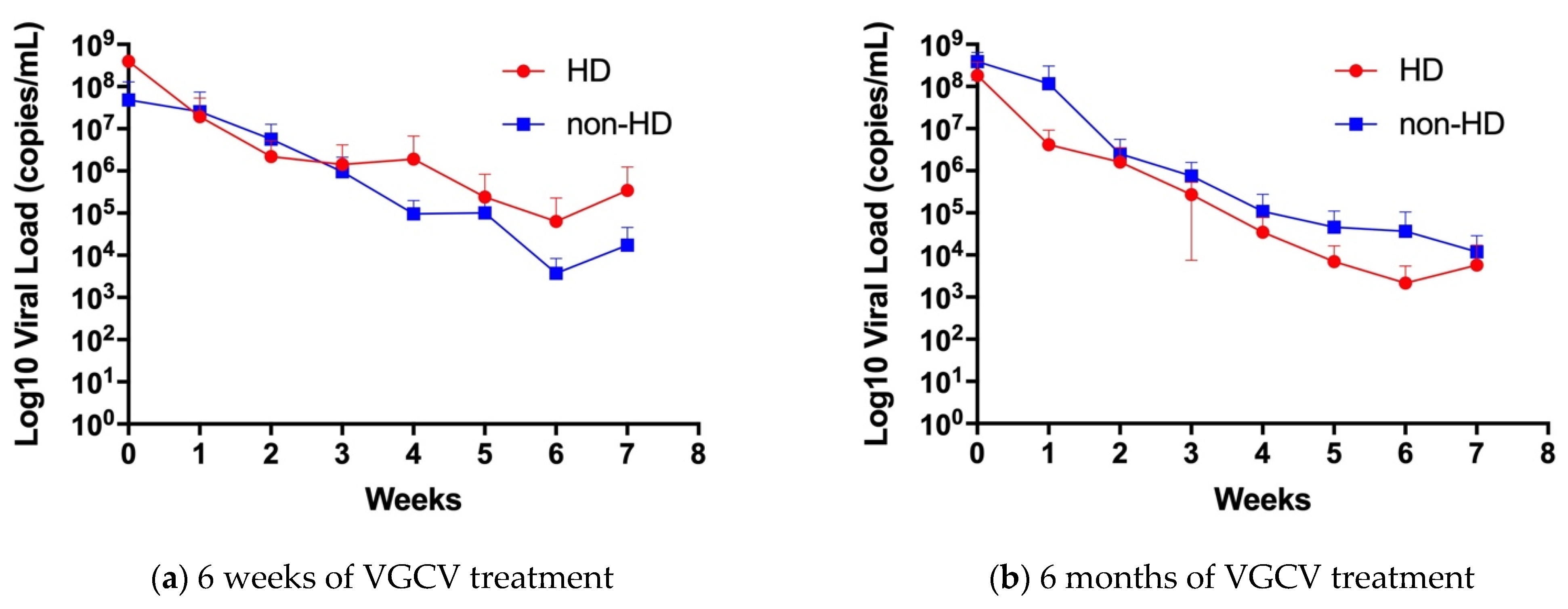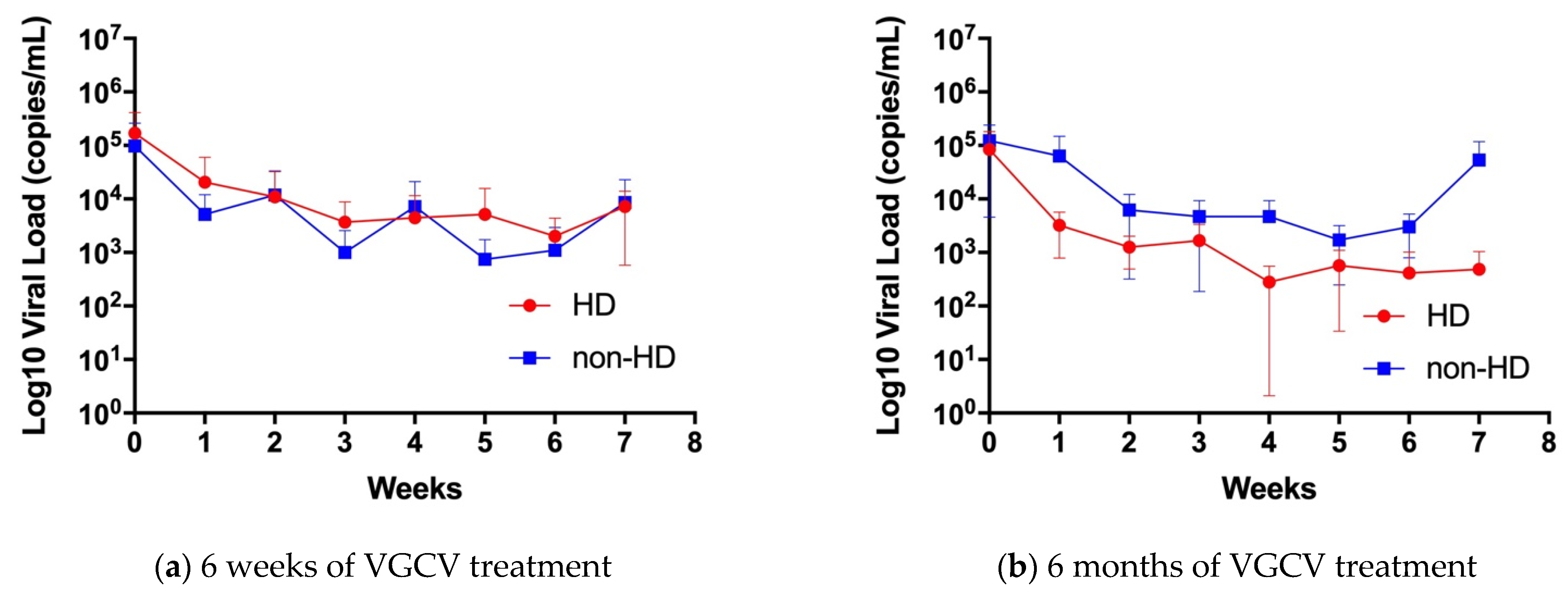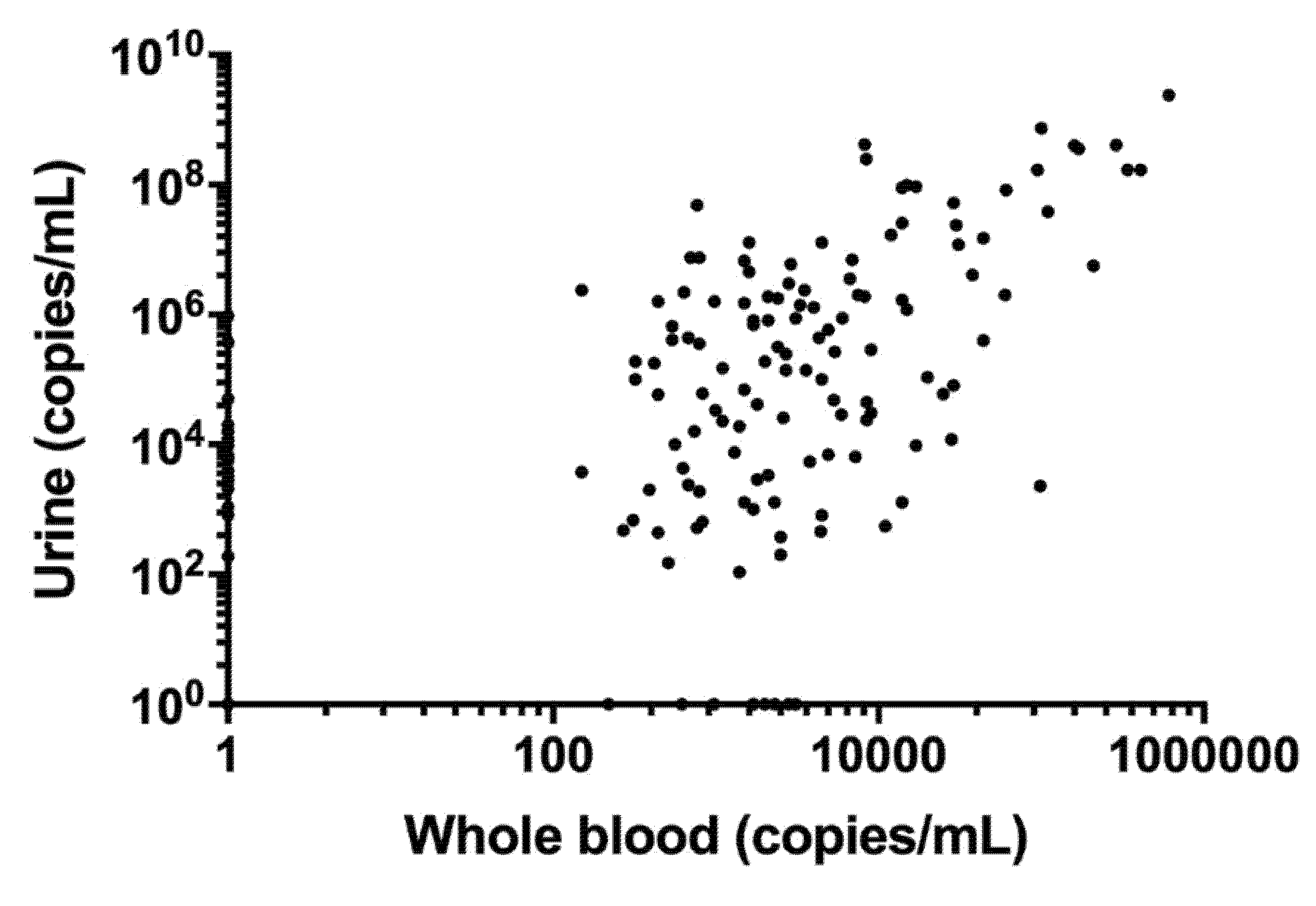Change in Viral Load during Antiviral Therapy Is Not Useful for the Prediction of Hearing Dysfunction in Symptomatic Congenital Cytomegalovirus Infection
Abstract
:1. Introduction
2. Materials and Methods
2.1. Study Design and Patients
2.2. Measuring CMV Viral Load in the Blood and Urine
2.3. VGCV Treatment Protocols
2.4. Statistical Analysis
3. Results
3.1. Patient Characteristics
3.2. Changes of Viral Load in the Whole Blood and Urine
3.3. Changes of Viral Load in 6 Weeks and 6 Months VGCV Treatment
3.4. Correlation between the Urine and Whole Blood Viral Load
4. Discussion
5. Conclusions
Supplementary Materials
Author Contributions
Funding
Institutional Review Board Statement
Informed Consent Statement
Data Availability Statement
Acknowledgments
Conflicts of Interest
References
- Rawlinson, W.D.; Boppana, S.B.; Fowler, K.B.; Kimberlin, D.W.; Lazzarotto, T.; Alain, S.; Daly, K.; Doutre, S.; Gibson, L.; Giles, M.L.; et al. Congenital cytomegalovirus infection in pregnancy and the neonate: Consensus recommendations for prevention, diagnosis, and therapy. Lancet Infect. Dis. 2017, 17, e177–e188. [Google Scholar] [CrossRef]
- Kimberlin, D.W.; Lin, C.Y.; Sanchez, P.J.; Demmler, G.J.; Dankner, W.; Shelton, M.; Jacobs, R.F.; Vaudry, W.; Pass, R.F.; Kiell, J.M.; et al. Effect of ganciclovir therapy on hearing in symptomatic congenital cytomegalovirus disease involving the central nervous system: A randomized, controlled trial. J. Pediatr. 2003, 143, 16–25. [Google Scholar] [CrossRef]
- Kimberlin, D.W.; Jester, P.M.; Sanchez, P.J.; Ahmed, A.; Arav-Boger, R.; Michaels, M.G.; Ashouri, N.; Englund, J.A.; Estrada, B.; Jacobs, R.F.; et al. Valganciclovir for symptomatic congenital cytomegalovirus disease. N. Engl. J. Med. 2015, 372, 933–943. [Google Scholar] [CrossRef] [PubMed] [Green Version]
- Ziv, L.; Yacobovich, J.; Pardo, J.; Yarden-Bilavsky, H.; Amir, J.; Osovsky, M.; Bilavsky, E. Hematologic Adverse Events Associated With Prolonged Valganciclovir Treatment in Congenital Cytomegalovirus Infection. Pediatr. Infect. Dis. J. 2019, 38, 127–130. [Google Scholar] [CrossRef] [PubMed]
- Ohyama, S.; Morioka, I.; Fukushima, S.; Yamana, K.; Nishida, K.; Iwatani, S.; Fujioka, K.; Matsumoto, H.; Imanishi, T.; Nakamachi, Y.; et al. Efficacy of Valganciclovir Treatment Depends on the Severity of Hearing Dysfunction in Symptomatic Infants with Congenital Cytomegalovirus Infection. Int. J. Mol. Sci. 2019, 20, 1388. [Google Scholar] [CrossRef] [PubMed] [Green Version]
- Fukushima, S.; Morioka, I.; Ohyama, S.; Nishida, K.; Iwatani, S.; Fujioka, K.; Mandai, T.; Matsumoto, H.; Nakamachi, Y.; Deguchi, M.; et al. Prediction of poor neurological development in patients with symptomatic congenital cytomegalovirus diseases after oral valganciclovir treatment. Brain Dev. 2019, 41, 743–750. [Google Scholar] [CrossRef] [PubMed]
- Nishida, K.; Fujioka, K.; Sugioka, Y.; Abe, S.; Ashina, M.; Fukushima, S.; Ohyama, S.; Ikuta, T.; Tanimura, K.; Yamada, H.; et al. Prediction of Neurodevelopmental Impairment in Congenital Cytomegalovirus Infection by Early Postnatal Magnetic Resonance Imaging. Neonatology 2020, 117, 460–466. [Google Scholar] [CrossRef] [PubMed]
- Boppana, S.B.; Fowler, K.B.; Pass, R.F.; Rivera, L.B.; Bradford, R.D.; Lakeman, F.D.; Britt, W.J. Congenital cytomegalovirus infection: Association between virus burden in infancy and hearing loss. J. Pediatr. 2005, 146, 817–823. [Google Scholar] [CrossRef] [PubMed]
- Lanari, M.; Lazzarotto, T.; Venturi, V.; Papa, I.; Gabrielli, L.; Guerra, B.; Landini, M.P.; Faldella, G. Neonatal cytomegalovirus blood load and risk of sequelae in symptomatic and asymptomatic congenitally infected newborns. Pediatrics 2006, 117, e76–e83. [Google Scholar] [CrossRef] [PubMed] [Green Version]
- Forner, G.; Abate, D.; Mengoli, C.; Palu, G.; Gussetti, N. High Cytomegalovirus (CMV) DNAemia Predicts CMV Sequelae in Asymptomatic Congenitally Infected Newborns Born to Women With Primary Infection During Pregnancy. J. Infect. Dis. 2015, 212, 67–71. [Google Scholar] [CrossRef] [PubMed] [Green Version]
- Tanimura, K.; Tairaku, S.; Morioka, I.; Ozaki, K.; Nagamata, S.; Morizane, M.; Deguchi, M.; Ebina, Y.; Minematsu, T.; Yamada, H. Universal Screening With Use of Immunoglobulin G Avidity for Congenital Cytomegalovirus Infection. Clin. Infect. Dis. 2017, 65, 1652–1658. [Google Scholar] [CrossRef] [PubMed] [Green Version]
- Tanimura, K.; Yamada, H. Potential Biomarkers for Predicting Congenital Cytomegalovirus Infection. Int. J. Mol. Sci. 2018, 19, 3760. [Google Scholar] [CrossRef] [PubMed] [Green Version]
- Tanimura, K.; Yamada, H. Maternal and neonatal screening methods for congenital cytomegalovirus infection. J. Obstet. Gynaecol. Res. 2019, 45, 514–521. [Google Scholar] [CrossRef] [PubMed] [Green Version]
- Nishida, K.; Morioka, I.; Nakamachi, Y.; Kobayashi, Y.; Imanishi, T.; Kawano, S.; Iwatani, S.; Koda, T.; Deguchi, M.; Tanimura, K.; et al. Neurological outcomes in symptomatic congenital cytomegalovirus-infected infants after introduction of newborn urine screening and antiviral treatment. Brain Dev. 2016, 38, 209–216. [Google Scholar] [CrossRef] [PubMed]
- Koyano, S.; Inoue, N.; Oka, A.; Moriuchi, H.; Asano, K.; Ito, Y.; Yamada, H.; Yoshikawa, T.; Suzutani, T. Japanese Congenital Cytomegalovirus Study Group. Screening for congenital cytomegalovirus infection using newborn urine samples collected on filter paper: Feasibility and outcomes from a multicentre study. BMJ Open 2011, 1, e000118. [Google Scholar] [CrossRef] [PubMed]
- Kobayashi, Y.; Morioka, I.; Koda, T.; Nakamachi, Y.; Okazaki, Y.; Noguchi, Y.; Ogi, M.; Chikahira, M.; Tanimura, K.; Ebina, Y.; et al. Low total IgM values and high cytomegalovirus loads in the blood of newborns with symptomatic congenital cytomegalovirus infection. J. Perinat. Med. 2015, 43, 239–243. [Google Scholar] [CrossRef] [PubMed] [Green Version]
- Ohyama, S.; Fujioka, K.; Fukushima, S.; Abe, S.; Ashina, M.; Ikuta, T.; Nishida, K.; Matsumoto, H.; Nakamachi, Y.; Tanimura, K.; et al. Diagnostic Value of Cytomegalovirus IgM Antibodies at Birth in PCR-Confirmed Congenital Cytomegalovirus Infection. Int. J. Mol. Sci. 2019, 20, 3239. [Google Scholar] [CrossRef] [PubMed] [Green Version]
- Kawada, J.; Torii, Y.; Kawano, Y.; Suzuki, M.; Kamiya, Y.; Kotani, T.; Kikkawa, F.; Kimura, H.; Ito, Y. Viral load in children with congenital cytomegalovirus infection identified on newborn hearing screening. J. Clin. Virol. 2015, 65, 41–45. [Google Scholar] [CrossRef] [PubMed]
- Marsico, C.; Aban, I.; Kuo, H.; James, S.H.; Sanchez, P.J.; Ahmed, A.; Arav-Boger, R.; Michaels, M.G.; Ashouri, N.; Englund, J.A.; et al. Blood Viral Load in Symptomatic Congenital Cytomegalovirus Infection. J. Infect. Dis. 2019, 219, 1398–1406. [Google Scholar] [CrossRef] [PubMed]
- Kocon, S.; Skorkiewicz, K.; Strek, P.; Ziarno, R.; Skladzien, J.; Hartwich, P.; Tomik, J. Stability of ABR Wave V Threshold in Early Hearing Diagnostics in Children from Selected Groups at Risk of Congenital Hearing Loss. Otolaryngol. Pol. 2020, 75, 7–15. [Google Scholar] [PubMed]




| Clinical Characteristics | HD Group (n = 12) | non-HD Group (n = 8) | p Value |
|---|---|---|---|
| Gestational age, weeks | 37 (33–40) | 36 (30–40) | 0.61 |
| Birth weight, g | 2261 (1255–3312) | 2321 (940–2848) | 0.91 |
| Outborns | 5/12 (42) | 3/8 (38) | 0.67 |
| Male | 3/12 (25) | 2/8 (25) | 1.00 |
| Neonatal asphyxia $ | 5/10 (50) | 4/8 (50) | 1.00 |
| Thrombocytopenia | 5/12 (42) | 5/8 (63) | 0.65 |
| Liver dysfunction | 4/12 (33) | 2/8 (25) | 1.00 |
| Microcephaly | 4/12 (33) | 2/8 (25) | 1.00 |
| Brain imaging abnormality | 12/12 (100) | 8/8 (100) | 1.00 |
| Eye complications | 2/12 (17) | 3/8 (38) | 0.35 |
| Small for gestational age | 5/12 (42) | 2/8 (25) | 0.64 |
| CMV load in blood before VGCV treatment, copies/mL | 3.7 × 104 (7.7 × 102–6.1 × 105) | 6.7 × 104 (1.5 × 103–3.4 × 105) | 0.97 |
| CMV load in urine before VGCV treatment, copies/mL | 8.9 × 107 (4.0 × 105–2.4 × 109) | 9.8 × 108 (1.5 × 106–4.1 × 108) | 0.52 |
| ABR abnormality before VGCV treatment | (n = 24 ears) | (n = 16 ears) | |
| most severe (≥91 dB) | 7/24 (29) | 1/16 (6) | 0.11 |
| severe (61–90 dB) | 5/24 (21) | 1/16 (6) | 0.37 |
| moderate (41–60 dB) | 3/24 (13) | 4/16 (25) | 0.40 |
| mild (31–40 dB) | 5/24 (21) | 1/16 (6) | 0.37 |
| normal (≤30 dB) | 4/24 (17) | 9/16 (56) | 0.02 |
| ABR abnormality at 6 months of corrected age | (n = 24 ears) | (n = 16 ears) | |
| most severe (≥91 dB) | 7/24 (29) | 0/16 (0) | 0.03 |
| severe (61–90 dB) | 3/24 (13) | 0/16 (0) | 0.26 |
| moderate (41–60 dB) | 6/24 (25) | 0/16 (0) | 0.06 |
| mild (31–40 dB) | 5/24 (21) | 0/16 (0) | 0.07 |
| normal (≤30 dB) | 3/24 (13) | 16/16 (100) | <0.01 |
| ABR abnormality at 12–18 months of corrected age # | (n = 16 ears) | (n = 14 ears) | |
| most severe (≥91 dB) | 5/16 (31) | 0/14 (0) | 0.04 |
| severe (61–90 dB) | 1/16 (6) | 0/14 (0) | 1.00 |
| moderate (41–60 dB) | 6/16 (38) | 0/14 (0) | 0.02 |
| mild (31–40 dB) | 0/16 (0) | 1/14 (7) | 0.47 |
| normal (≤30 dB) | 4/16 (25) | 13/14 (93) | <0.01 |
Publisher’s Note: MDPI stays neutral with regard to jurisdictional claims in published maps and institutional affiliations. |
© 2021 by the authors. Licensee MDPI, Basel, Switzerland. This article is an open access article distributed under the terms and conditions of the Creative Commons Attribution (CC BY) license (https://creativecommons.org/licenses/by/4.0/).
Share and Cite
Kido, T.; Kyono, Y.; Suga, S.; Nakasone, R.; Abe, S.; Ashina, M.; Matsumoto, H.; Tanimura, K.; Nozu, K.; Fujioka, K. Change in Viral Load during Antiviral Therapy Is Not Useful for the Prediction of Hearing Dysfunction in Symptomatic Congenital Cytomegalovirus Infection. J. Clin. Med. 2021, 10, 5864. https://doi.org/10.3390/jcm10245864
Kido T, Kyono Y, Suga S, Nakasone R, Abe S, Ashina M, Matsumoto H, Tanimura K, Nozu K, Fujioka K. Change in Viral Load during Antiviral Therapy Is Not Useful for the Prediction of Hearing Dysfunction in Symptomatic Congenital Cytomegalovirus Infection. Journal of Clinical Medicine. 2021; 10(24):5864. https://doi.org/10.3390/jcm10245864
Chicago/Turabian StyleKido, Takumi, Yuki Kyono, Shutaro Suga, Ruka Nakasone, Shinya Abe, Mariko Ashina, Hisayuki Matsumoto, Kenji Tanimura, Kandai Nozu, and Kazumichi Fujioka. 2021. "Change in Viral Load during Antiviral Therapy Is Not Useful for the Prediction of Hearing Dysfunction in Symptomatic Congenital Cytomegalovirus Infection" Journal of Clinical Medicine 10, no. 24: 5864. https://doi.org/10.3390/jcm10245864
APA StyleKido, T., Kyono, Y., Suga, S., Nakasone, R., Abe, S., Ashina, M., Matsumoto, H., Tanimura, K., Nozu, K., & Fujioka, K. (2021). Change in Viral Load during Antiviral Therapy Is Not Useful for the Prediction of Hearing Dysfunction in Symptomatic Congenital Cytomegalovirus Infection. Journal of Clinical Medicine, 10(24), 5864. https://doi.org/10.3390/jcm10245864







